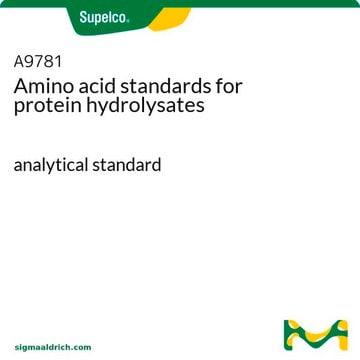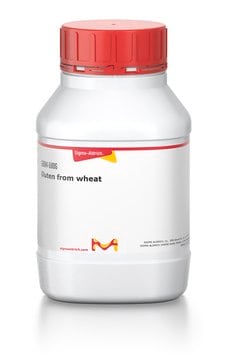S5201
Sericin Bombyx mori (silkworm)
Synonym(s):
Bombyx mori Extract, Sericin Protein
Sign Into View Organizational & Contract Pricing
All Photos(7)
About This Item
UNSPSC Code:
12352202
NACRES:
NA.75
Recommended Products
form
powder
technique(s)
cell culture | mammalian: suitable
impurities
≤1 EU/mL endotoxin
≤100 CFU/g total microbial count (Bacteria)
≤100 CFU/g total yeast and mold (Fungi)
Gene Information
silkworm ... Ser2(100379325) , Ser3(100136948)
General description
Sericin, a water-soluble globular glycoprotein, is derived from the silkworm Bombyx mori. It is rich in serine, aspartic acid, and glycine. Sericin is localized around the fibroin fibers with successive sticky layers, to form the cocoon. It constitutes 20%-30% of the total cocoon mass. Sericin is composed of 18 types of amino acids of which most of them contain strong polar (hydroxyl, carboxyl, and amino) side groups.
Application
Sericin Bombyx mori (silkworm) has been used:
- as a standard to evaluate the physicochemical and biological characteristics of the crude sericin extracts
- as a growth medium supplement to culture to study its effect on the production of infectious Zika virus (ZIKV) particles by C6/36 and Vero cells, compared to serum-free cultures and cultures supplemented with 5% fetal bovine serum (FBS)
- in the development and optimization of a bio-origami film for skin regeneration
Biochem/physiol Actions
Sericin acts as a gum binder to maintain the intact structure of the cocoon. The strong polar side groups of sericin affect its physical and biological properties. Studies show that sericin exhibits various biological functions such as antioxidant and antityrosinase activities, collagen production that is essential in wound healing, anti-inflammatory, antitumoral, anti-aging, and antimicrobial actions. It is known to promote stability and prolong the release of controlled drug-releasing biomaterials. Sericin has several beneficial characteristics for culturing mammalian cells.
Features and Benefits
- Sericin has cryoprotective properties that allow for replacement of fetal bovine serum (FBS) in cryopreservation media.
- 1% sericin (w/v) along with 0.5% (w/v) maltose, 0.3% (w/v) proline, 0.3% (w/v) glutamine and 10% dimethyl sulfoxide (DMSO) is comparable to 90% FBS and 10% DMSO.
- Sericin can act as a FBS replacement in cell culture and stimulate cell growth.
- In certain situations, it can inhibit cell death.
Storage Class Code
11 - Combustible Solids
WGK
WGK 3
Flash Point(F)
Not applicable
Flash Point(C)
Not applicable
Certificates of Analysis (COA)
Search for Certificates of Analysis (COA) by entering the products Lot/Batch Number. Lot and Batch Numbers can be found on a product’s label following the words ‘Lot’ or ‘Batch’.
Already Own This Product?
Find documentation for the products that you have recently purchased in the Document Library.
Customers Also Viewed
Kozo Tsubouchi et al.
Bioscience, biotechnology, and biochemistry, 69(2), 403-405 (2005-02-24)
Human skin fibroblasts were cultured on sericin prepared from cocoon shells. The living cell number after 72 h was enhanced to 250% of the no-sericin control. The increase was due to the acceleration of the initial attachment of the cells.
Masahiro Sasaki et al.
Biotechnology and applied biochemistry, 42(Pt 2), 183-188 (2005-06-10)
Cryopreservation is a pivotal process in cellular engineering for creating a continuous source of generated functional cell lines and for the convenience of various medical treatments that involve cell culture. FBS (fetal bovine serum) supplemented with 10% (v/v) DMSO is
Lin Niu et al.
Molecular medicine reports, 23(2) (2020-12-15)
Triple negative breast cancer (TNBC) is a subtype of breast cancer characterized by an aggressive histology and poor prognosis, with limited treatment options in the clinic. In the present study, the effect of sericin, as an anti‑cancer drug, on TNBC
Ana C Alcalá et al.
Journal of biotechnology, 353, 28-35 (2022-05-28)
Sericin, a silk-derived non-immunogenic protein, has been used to improve cell culture performance by increasing viability, cell concentration, and promoting adherence of several cell lines. Here, we hypothesized that the properties of sericin can enhance the amplification of flaviviruses in
Kunat Suktham et al.
Colloids and surfaces. B, Biointerfaces, 148, 487-495 (2016-11-05)
Sericin protein (SP) is widely used as a nutrient biomaterial for biomedical and cosmeceutical applications although it shows low stability to heat and light. To overcome these problems and add value to wastewater from the silk industry, sericin protein was
Our team of scientists has experience in all areas of research including Life Science, Material Science, Chemical Synthesis, Chromatography, Analytical and many others.
Contact Technical Service












